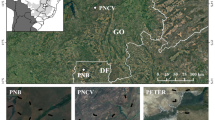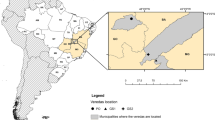Abstract
We investigated the relationship between soil pH/calcium content and species richness of vascular plants in seven broadly defined Central European vegetation types, using Ellenberg indicator values for soil reaction and a phytosociological data set of 11,041 vegetation sample plots from the Czech Republic. The vegetation types included (A) broad-leaved deciduous forests, (B) meadows, (C) dry grasslands, (D) reed-bed and tall-sedge vegetation, (E) fens and transitional mires, (F) perennial synanthropic vegetation and (G) annual synanthropic vegetation. Relationships between local species richness (alpha diversity) and pH/calcium were positive for vegetation types A and C, negative for D and G, unimodal for E, and insignificant for B and F. Ellenberg soil reaction values explained 37% of variation in local species richness for vegetation type E, 24% for A, 13% for D, but only less than 4% for the others. Species pool size, i.e., the number of species that can potentially occur in a given habitat, was calculated for each plot using Beals index of sociological favourability applied to a large phytosociological database. For most vegetation types, the relationships between species pool size and pH/calcium were similar to the relationships between local species richness and pH/calcium, with the exception of meadows (weak unimodal) and perennial synanthropic vegetation (weak negative).
These patterns suggest that for those types of Central European vegetation that developed independently of human influence in the Pleistocene or early Holocene (dry grasslands, deciduous forests), there are larger pools of calcicole than calcifuge species. This pattern is also found at the level of local species richness, where it is, however, less clearly pronounced, possibly due to the predominance of a few widespread and generalist calcifuges in acidic habitats. The unimodal pattern found in mires may result from similar underlying mechanisms, but in high pH environments mineral-rich spring waters probably decrease species richness by having toxic effects on plant growth. By contrast, vegetation types developed under direct human influence (meadows, synathropic vegetation) show weak negative or no relationships of local species richness or species pool to pH/calcium gradient. These results support the hypothesis ofPärtel (Ecology 83: 2361–2366, 2002) andEwald (Folia Geobot. 38: 357–366, 2003), that the modern calcicole/calcifuge disparity in the species pool of Central European flora has resulted from historical and evolutionary processes that took place on high pH soils. In the Pleistocene, calcareous soils dominated both the dry continental landscapes of Central Europe and glacial refugia of temperate flora, which were mostly situated in southern European mountain ranges with abundant limestone and dolomite. The negative pattern of species richness along the pH/calcium gradient found in reed-bed and tall-sedge vegetation, however, is not consistent with this historical explanation.
Similar content being viewed by others
References
Beals E.W. (1984): Bray-Curtis-ordination: an effective strategy for analysis of multivariate ecological data.Advances Ecol. Res. 14: 1–55.
Behrensmeyer A.K., Damuth J., DiMichele W., Potts R., Sues H.D. &Wing S. (1992):Terrestrial ecosystems through time. Chicago University Press, Chicago.
Berglund B.E., Birks H.J.B., Ralska-Jasiewiczowa M. &Wright H.E. (1996):Palaeoecological events during the last 15 000 years. Wiley, Chichester.
Brosofske K.D., Chen J. &Crow T.R. (2001): Understory vegetation and site factors: implications for a managed Wisconsin landscape.Forest Ecol. Managem. 146: 75–87.
Brunet J., Falkengren-Grerup U., Rühling A. &Tyler G. (1997): Regional differences in floristic change in South Swedish oak forests as related to soil chemistry and land use.J. Veg. Sci. 8: 329–336.
Caley M.J. &Schluter D. (1997): The relationship between local and regional diversity.Ecology 78: 70–80.
Chytrý M. (2001): Phytosociological data give biased estimates of species richness.J. Veg. Sci. 12: 439–444.
Chytrý M. &Rafajová M. (2003): Czech National Phytosociological Database: basic statistics of the available vegetation-plot data.Preslia 75: 1–15.
Cornell H.V. &Lawton J.H. (1992): Species interactions, local and regional processes, and limits to the richness of ecological communities — a theoretical perspective.J. Anim. Ecol. 61: 1–12.
Diekmann M. &Lawesson J.E. (1999): Shifts in ecological behaviour of herbaceous forests species along a transect from northern Central to North Europe.Folia Geobot. 34: 127–141.
Dumortier M., Butaye J., Jacquemyn H., Van Camp N., Lust N. &Hermy M. (2002): Predicting vascular plant species richness of fragmented forests in agricultural landscapes in central Belgium.Forest Ecol. Managem. 158: 85–102.
Dupré C., Wessberg C. &Diekmann M. (2002): Species richness in deciduous forests: Effects of species pools and environmental variables.J. Veg. Sci. 13: 505–516.
Ellenberg H., Weber H.E., Düll R., Wirth W., Werner W. &Paulißen D. (1992): Zeigerwerte von Pflanzen in Mitteleuropa. Ed. 2.Scripta Geobot. 18: 1–258.
Eriksson O. (1993): The species-pool hypothesis and plant community diversity.Oikos 68: 371–374.
Ewald J. (2001): Der Beitrag pflanzensoziologischer Datenbanken zur vegetationsökologischen Forschung.Ber. Reinhold-Tüxen-Ges. 13: 53–69.
Ewald J. (2002): A probabilistic approach to estimating species pools from large compositional matrices.J. Veg. Sci. 13: 191–198.
Ewald J. (2003): The calcareous riddle: Why are there so many calciphilous species in the Central European flora?Folia Geobot. 38: 357–366 (this issue).
Exner A., Willner W. &Grabherr G. (2002):Picea abies andAbies alba forests of the Austrian Alps: numerical classification and ordination.Folia Geobot. 37: 383–402.
Glaser P.H., Janssens J.A. &Siegel D.I. (1990): The response of vegetation to chemical and hydrological gradients in the Lost River peatland, northern Minnesota.J. Ecol. 78: 1021–1048.
Gough L., Grace J.B. &Taylor K.L. (1994): The relationship between species richness and community biomass: the importance of environmental variables.Oikos 70: 271–279.
Gough L, Shaver G.R., Carroll J., Royer D.L. &Laundre J.A. (2000): Vascular plant species richness in Alaskan arctic tundra: the importance of soil pH.J. Ecol. 88: 54–66.
Gould W. &Walker M.D. (1999): Plant communities and landscape diversity along a Canadian Arctic river.J. Veg. Sci. 10: 537–548.
Grace J.B. (1999): The factors controlling species density in herbaceous plant communities.Perspect. Pl. Ecol. Evol. Syst. 3: 1–28.
Grace J.B. (2001): Difficulties with estimating and interpreting species pools and the implications for understanding patterns of diversity.Folia Geobot. 36: 71–83.
Grime J.P. (1973): Control of species density in herbaceous vegetation.J. Environm. Managem. 1: 151–167.
Grime J.P. (1979):Plant strategies and vegetation processes. Wiley, Chichester.
Grubb P.J. (1987): Global trends in species-richness in terrestrial vegetation: a view from the northern hemisphere. In:Gee J.H.R. &Giller P.S. (eds.),Organization of communitiesd Past and present, Blackwell, Oxford, pp. 99–118.
Gunnarsson U., Rydin H. &Sjörs H. (2000): Diversity and pH changes after 50 years on the boreal mire Skattlosbergs Stormosse, Central Sweden.J. Veg. Sci. 11: 277–286.
Hájková P. &Hájek M. (2003): Species richness and above-ground biomass of poor and calcareous spring fens in the flysch West Carpathians, and their relationship to water and soil chemistry.Preslia 75: 271–287.
Hennekens S.M. &Schaminée J.H.J. (2001): TURBOVEG, a comprehensive data base management system for vegetation data.J. Veg. Sci. 12: 589–591.
Herben T. (2000): Correlation between richness per unit area and the species pool cannot be used to demonstrate the species pool effect.J. Veg. Sci. 11: 123–126.
Hill M.O. &Carey P.D. (1997): Prediction of yield in the Rothamsted Park Grass Experiment by Ellenberg indicator values.J. Veg. Sci. 8: 579–586.
Huntley B. &Birks H.J.B. (1983):An atlas of past and present pollen maps for Europe: 0–13 000 years ago. Cambridge University Press, Cambridge.
Huston M.A. (1994).Biological diversity. The coexistence of species on changing landscapes. Cambridge Univ. Press, Cambridge.
Lang G. (1994):Quartäre Vegetationsgeschichte Europas. G. Fischer, Jena, Stuttgart, New York.
Lepš J. (2001): Species-pool hypothesis: limits to its testing.Folia Geobot. 36: 45–52.
McCune B. (1994): Improving community analysis with the Beals smoothing function.Écoscience 1: 82–86.
Moravec J., Balátová-Tuláčková E., Blažková D., Hadač E., Hejný S., Husák Š., Jeník J., Kolbek J., Krahulec F., Kropáč Z., Neuhäusl R., Rybníček K., Řehořek V. & Vicherek J. (1995): Rostlinná společenstva České republiky a jejich ohrožení (Red list of plant communities of the Czech Republic and their endangerment). Ed. 2.Severočeskou Přír., Suppl. 1995: 1–206.
Niklfeld H. (1972):Der niederösterreichische Alpenostrand — ein Glazialrefugium montaner Pflanzensippen. Verein zum Schutze der Alpenpflanzen und -Tiere, München.
Olde Venterink H., Wassen M.J., Belgers J.D.M. &Verhoeven J.T.A. (2001): Control of environmental variables on species density in fens and meadows: importance of direct effects and effects through community biomass.J. Ecol. 89: 1033–1040.
Pärtel M. (2002): Local plant diversity patterns and evolutionary history at the regional scale.Ecology 83: 2361–2366.
Pärtel M., Zobel M., Zobel K. &van der Maarel E. (1996): The species pool and its relation to species richness: evidence from Estonian plant communities.Oikos 75: 111–117.
Peet R.K. &Christensen N.L. (1980): Hardwood forest vegetation of the North Carolina piedmont.Veröff. Geobot. Inst. ETH Stiftung Rübel, Zürich 69: 14–39.
Prinzing A., Durka W., Klotz S. &Brandl R. (2001): The niche of higher plants: evidence for phylogenetic conservatism.Proc. Roy. Soc. London, Ser. B, Biol. Sci. 268: 2383–2389.
Pyšek P., Sádlo J. &Mandák B. (2002): Catalogue of alien plants of the Czech Republic.Preslia 74: 97–186.
Rey Benayas J.M. (1995): Patterns of diversity in the strata of boreal montane forest in British Columbia.J. Veg. Sci. 6: 95–98.
Rey Benayas J.M. &Scheiner S.M. (1993): Diversity patterns of wet meadows along geochemical gradients in central Spain.J. Veg. Sci. 4: 103–108.
Ricklefs R.E. &Schluter D. (1993):Species diversity in ecological communities. Historical and geographical perspectives. Univ. Chicago Press, Chicago, London.
Roberts N. (1998):The Holocene. An environmental history. Ed. 2. Blackwell, Oxford.
Rosenzweig M.L. (1995):Species diversity in space and time. Cambridge University Press, Cambridge.
Schaffers A.P. &Sýkora K.V. (2000): Reliability of Ellenberg indicator values for moisture, nitrogen and soil reaction: a comparison with field measurements.J. Veg. Sci. 11: 225–244.
Silvertown J.W. (1980): The dynamics of a grassland ecosystem: botanical equilibrium in the Park grass experiment.J. Appl. Ecol. 17: 491–504.
Sokal R.R. &Rohlf F.J. (1995):Biometry. Ed. 3. W.H. Freeman and Company, New York.
StatSoft Inc. (2001):STATISTICA (data analysis software system), version 6. www.statsoft.com.
Taylor D.R., Aarsen L.W. &Loehle C. (1990): On the relationship between r/K selection and environmental carrying capacity: a new habitat templet for plant life history strategies.Oikos 58: 239–250.
Tichý L. (2002): JUICE, software for vegetation classification.J. Veg. Sci. 13: 451–453.
Tilman D. &Olff H. (1991): An experimental study of the effects of pH and nitrogen on grassland vegetation.Acta Oecol. 12: 427–441.
Vitt D.H., Li Y. &Belland R.J. (1995): Patterns of bryophyte diversity in peatlands of continental western Canada.Bryologist 98: 218–227.
Walker D.A., Bockheim J.G., Chapin F.S., III,Eugster W., Nelson F.E. &Ping C.L. (2001): Calcium-rich tundra, wildlife, and the “Mammoth Steppe”.Quatern. Sci. Rev. 20: 149–163.
Wamelink G.W.W., Joosten V., van Dobben H.F. &Berendse F. (2002): Validity of Ellenberg indicator values judged from physico-chemical field measurements.J. Veg. Sci. 13: 269–278.
Wilson J.B. &Anderson B.J. (2001): Species-pool relations: like a wooden light bulb?Folia Geobot. 36: 35–44.
Zobel M. (1992): Plant species coexistence: the role of historical, evolutionary and ecological factors.Oikos 65: 314–320.
Zobel M. (1997): The relative role of species pools in determining plant species richness: an alternative explanation of species coexistence?Trends Ecol. Evol. 12: 266–269.
Author information
Authors and Affiliations
Corresponding author
Rights and permissions
About this article
Cite this article
Chytrý, M., Tichý, L. & Roleček, J. Local and regional patterns of species richness in Central European vegetation types along the pH/calcium gradient. Folia Geobot 38, 429–442 (2003). https://doi.org/10.1007/BF02803250
Received:
Revised:
Accepted:
Issue Date:
DOI: https://doi.org/10.1007/BF02803250




